 Yellowing and drying of the leaves in garlic and onions is considered normal if this occurs in late summer, before harvesting. But, if the leaves turn yellow in early spring or summer, it is necessary to clearly analyze the causes that can be eliminated.
Yellowing and drying of the leaves in garlic and onions is considered normal if this occurs in late summer, before harvesting. But, if the leaves turn yellow in early spring or summer, it is necessary to clearly analyze the causes that can be eliminated.
Content
What could be the problem and how to fix it?
- yellowing is directly affected by the quality of the planting material. That is why, first of all, you should choose onions for landing only high-quality, without damage. Before planting, they need to be treated with special preparations, for example, Fundazole. The treated bulbs are resistant to disease.
- lack or excess humidity - this reason is easy to identify. If stagnation of water forms in the garden, it is necessary to equip the outflow, which will help free the culture from excess moisture. If the summer is dry and arid, you need to water the onions and garlic more often, as necessary. For irrigation, you should use water with a temperature of 22-25 degrees, categorically it is impossible to water with cold water;
- the lack of any trace element in the soil - with a deficiency, it is necessary to fertilize with complex fertilizers. In this case, it is necessary to follow all dosage instructions and the schedule of fertilizing the culture;
- some diseases and pests contribute to the yellowing and drying of the tips of the feathers. As soon as the diagnosis is confirmed, the fight against them must be started immediately. Such pests as nematode and onion fly are very dangerous for the plant. Common diseases are fusarium or bacterial rot;
- return frosts can cause yellowing. If you plant onions or garlic in early autumn, the planting material quickly roots and sprouts begin to appear, which will freeze at the very first frost. The result will be yellowed leaves in spring. Planting these crops in the winter is necessary 3 weeks before frosts. If, nevertheless, early spring did not please the green onion and garlic feathers, you should immediately spray the plantings with Epin.
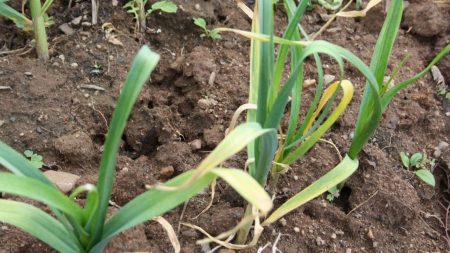
If watering and autumn freezing of bulbs and heads is excluded, it is necessary to apply to plant nutrition. Perhaps they lack some useful elements.
Organic Feeding
If the leaves turn yellow, onion or garlic shows that it lacks nitrogen and potassium. The best feeding in this case is a solution of mullein or chicken droppings. For preparation, you need 1 liter of any fertilizer to insist 3 days in 5 liters of water. When the mixture is ready, it must be diluted in 12 liters of water and applied not under the root of the bulbs, but between the rows.
It is worth remembering that fresh mullein and chicken droppings, used as fertilizer can be a source of bacterial and fungal diseases, therefore it is recommended to use them in working solutions.
Green top dressing can be an excellent remedy that compensates for the lack of nitrogen and potassium. Cooking it is quite simple. If there is a barrel of 200 l on the garden plot, the mixture can be prepared directly in it. Many vegetable and flower crops can be watered and fed with this remedy, so the residue after fertilizing onions and garlic is still useful.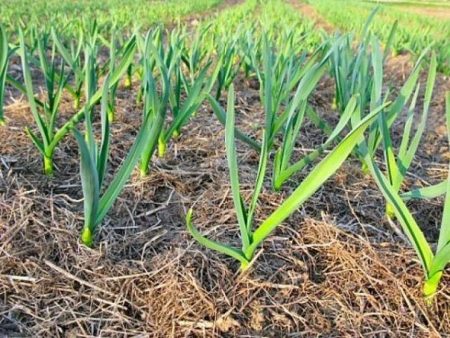
Fill the barrel with any weeds. You can use absolutely everything except poisonous plants and cereals. Add 1.5 l of wood ash, 200 g of fresh yeast and 1.5 l of whey to the weeds. Water fill a full barrel. Leave to roam for 2 weeks.Every day the mixture must be thoroughly mixed. The working solution is prepared 1:12 with water.
If the mullein was not found at hand, urea can be fed. For the solution you need 1 tbsp. l dilute the funds in a bucket of water, the plant is watered under the root at the rate of 3 liters of solution per 1 sq. m
Onions and garlic respond well to the introduction of organic fertilizers into the soil. They are capable of being evenly distributed in the soil and easily absorbed by plants.
The most common organics
- bird or chicken droppings - has in its composition much more useful trace elements than manure. For fertilizer, insist 0.5 liters of litter in 10 liters of water;
- humus - its solution is the best option for fertilizing garlic and onions. The composition may include: manure and plant debris;
- peat - is used mainly as one of the components of compost and is a highly acidic additive.
To use organic for onions and garlic is recommended by the root method. Watering is carried out strictly under the roots. The main thing, after such top dressing, on the morning of the next day, water the plant with plain water in order to wash off the remains of fertilizer from the roots.
Organic additives are added in 3 stages:
- 1 tbsp. slurry is dissolved in 10 liters of water.
- Slurry of manure mixed with plant debris is bred in 9 liters of water.
- 250 g of ash are diluted in 1 liter of boiling water, then dilute the mixture in 9 liters of water and insist 2 days.
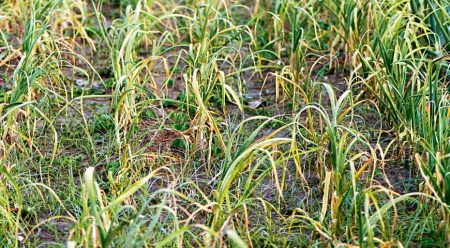
It is necessary to apply top dressing when the first sprouts appear, the second time - approximately 14 days after 1 top dressing. The third time the fertilizer is introduced into the phase of the formation of the bulbs and heads.
For 1 top dressing, it is recommended to use a mullein solution. Dilute 1: 7 with water, feed the plant under the root. Then fertilize the soil with ash, sprinkling it between the rows of landings. Then use chicken solution. He gets divorced 1:15 from the finished mixture.
In addition, it is recommended to fertilize onions and garlic with complex fertilizers. Finished preparations contain such necessary elements as potassium, phosphorus, nitrogen, humates, calcium, iron, zinc, sulfur, magnesium.
Folk remedies
In order for the onion leaves to acquire the usual healthy appearance, you can use effective folk methods against the yellowing of these crops.
Great remedies are:
- ammonia;
- hydrogen peroxide;
- baking yeast.
You can use any tool to solve this problem. They are especially attracted by their effectiveness and affordability.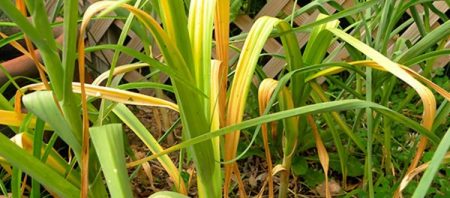
Ammonia
To feed onions or garlic, you need to dilute 5-6 tbsp. l funds in 10 liters of water and use only as a basal dressing.
Hydrogen peroxide
Favorably affects the development and growth of any seedlings, onions and garlic are no exception. The composition of the drug includes atomic oxygen, which is able to kill harmful microorganisms in the soil. In addition, it saturates the soil with oxygen, which is very important at different stages of plant development. For spraying in 10 liters of water you need to add 2 tbsp. l 3% hydrogen peroxide. Watering is recommended in early spring and with further development.
Yeast
Perfectly stimulate plant growth. Yeast promotes better root formation, increases resistance to diseases. Both fresh and dry yeast are used for top dressing. For the solution, you need to insist 0.5 kg of yeast, 0.5 kg of chopped weeds and 0.5 kg of bread crumb, in a small amount of water. Insist for 2 days. The resulting concentrated solution must be diluted in 10 liters of water and pour garlic or onions under the root.
Aerated Compost Tea
A new fertilizer that has already gained popularity among many gardeners.ACF - is a natural remedy or infusion of compost in water. Air-saturated or aerated compost is very valuable for growing garlic and onions. It creates all the conditions for the propagation of beneficial bacteria, which subsequently become useful nutrition for plants.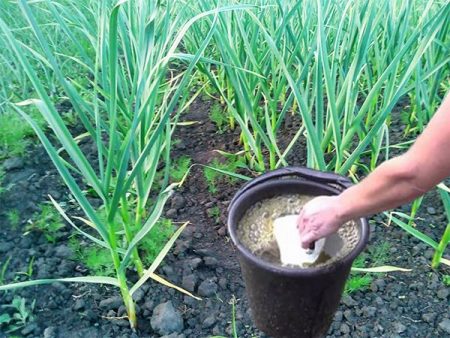
The bioactive and mineral substances that make up the AKF contribute to the activation of the photosynthesis process, resulting in a crop of large and tasty fruits, in this case bulbs and heads. You can prepare AKCh yourself.
Structure:
- old compost;
- for bacteria nutrition - old jam or beet molasses;
- rainwater;
- compressor for a 3 liter aquarium;
- 3 liter can.
To prepare the battery, you need to pour 2 liters of water in a 3 liter jar and add 20 ml of molasses to it, put the hose from the compressor into the container and turn on the device. After about 1 minute, add 1 tbsp of compost to the container. The solution is saturated with air for 24 hours. Once the fertilizer is ready, it must be applied to the soil immediately, after a maximum of 4 hours.
Mineral fertilizers
One of the effective mineral fertilizers for garlic and onions is Superphosphate. It can be used both in dry form and in solution. Crops respond quickly to its presence in the soil and begin active growth. For the solution you need 1 tbsp. l drug diluted in 2 tbsp. warm water and put overnight in a dark place. Then dilute in 10 liters of water. Planting should be watered under the root. You can also use Superphosphate in dry form. For this method, you just need to scatter it on the ground, sprinkle with soil and water.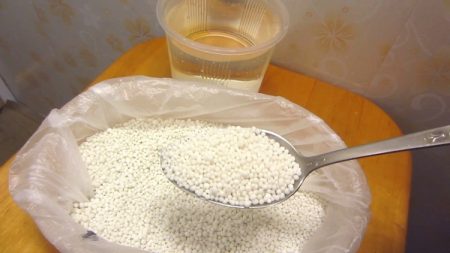
It will be useful to fertilize onions and garlic with ammonium nitrate or potassium salt. It is also recommended to use such drugs as: Reflex and Cinderella.
Pests and diseases
A dangerous enemy is a nematode. The worst thing is that if she wound up, fighting it is practically useless. In the soil, this pest can live 8-10 years. Moreover, during this period he can do without water and food. It is not difficult to determine the infection. Onion or garlic leaves turn yellow first, then begin to curl. To accurately verify the presence of a nematode, you need to dig one head. The diseased bulb is damaged by cracks, its bottom is covered with white or pink plaque, the roots rot. These are all signs of the presence of nematodes.
Infected bulbs will have to be dug up and destroyed. In the next season, onions and garlic can not be planted on this bed. They need to be moved away from the infected area. The pest can be purchased already with infected purchased onions, therefore, the choice of planting material should be taken seriously. Before planting, it is necessary to process the onions in a 3% salt solution at a temperature of 20-25 degrees, withstand them for about half an hour.
Nematodes like areas with acidic soil, so it is necessary to normalize the acidity with dolomite flour or slaked lime. The only salvation from adversity is landing on a plot of calendula or marigold. Flowers attract a pest with their aroma, sticks to flower roots, and then dies from the juice of plants poisonous to them.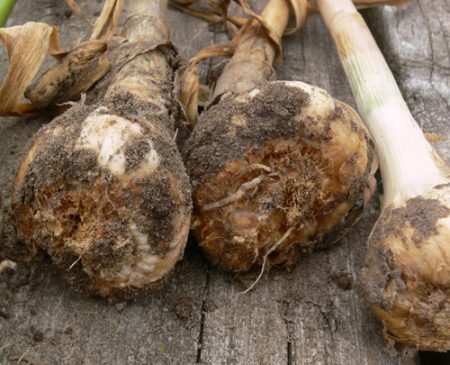
The onion fly is also harmful, or rather not even she herself, but her larvae. They look like little worms, which can also cause considerable damage to the crop. If you look closely, they can be seen next to the heads of onions and garlic. You can get rid of the worms with a saline solution (dilute 200 g of salt in 10 l of water and spray the plantings). The fly will leave the place on its own.
Disease prevention
Based on all the causes of chlorosis or yellowing of feathers of onions and garlic, violations of agricultural regulations lead to it. First of all, you need to analyze all the points that you need to pay special attention to:
- The right choice of planting material. For planting, you need to choose high-quality onions of the correct shape, without any damage. For planting garlic, large cloves are selected.
- Planting winter garlic and onions spend 3 weeks before resistant frosts.
- The bed for planting is fertilized in advance.
- Providing crops with regular and regular fertilizers and watering.
- Compliance with crop rotation.
If you follow all the rules for planting and growing garlic and onions, you can get a good harvest.

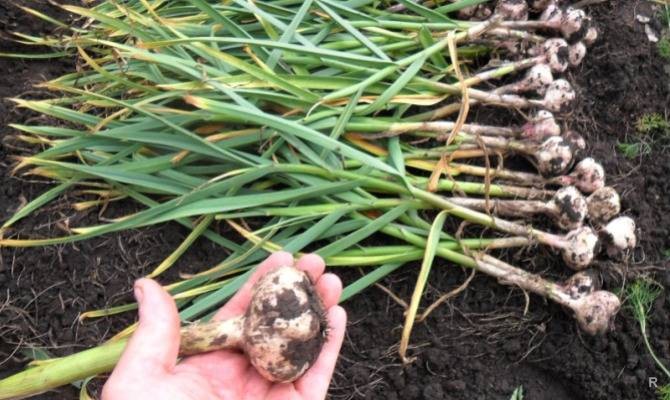
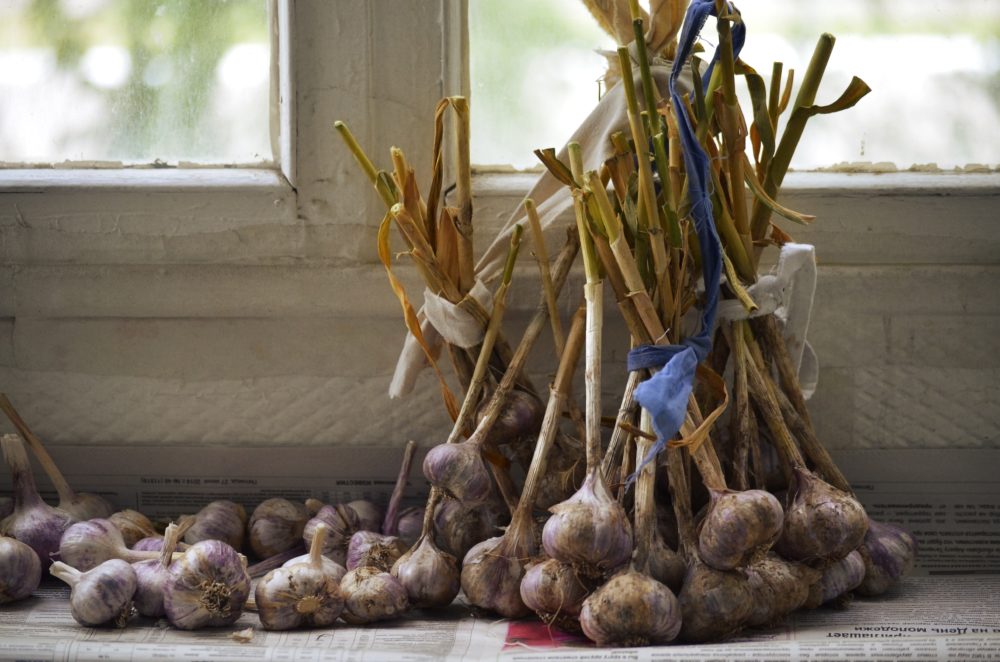
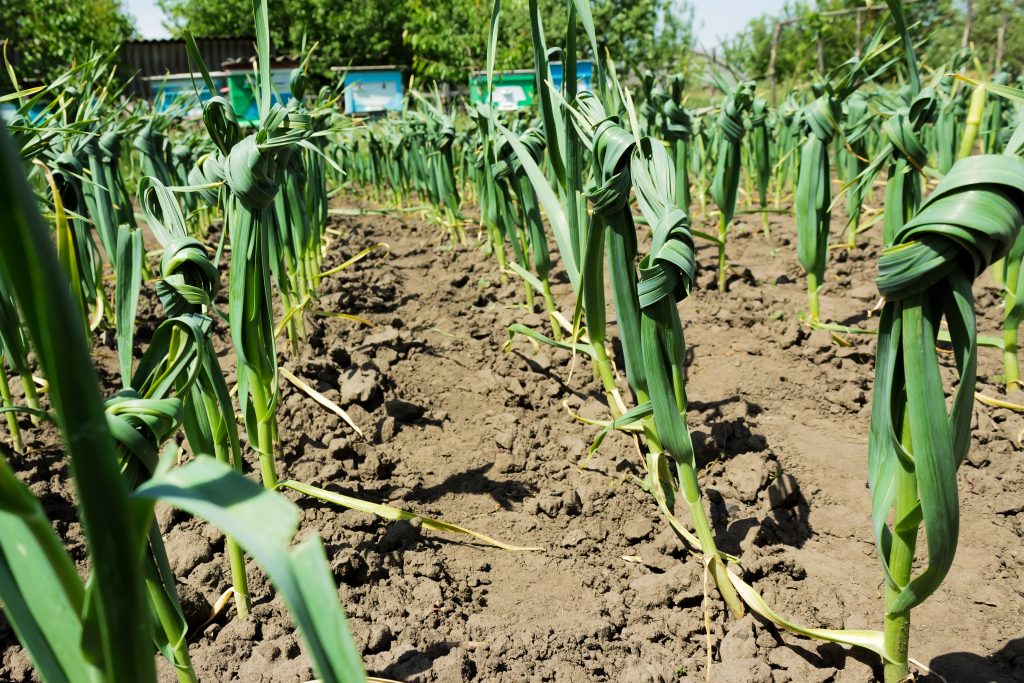
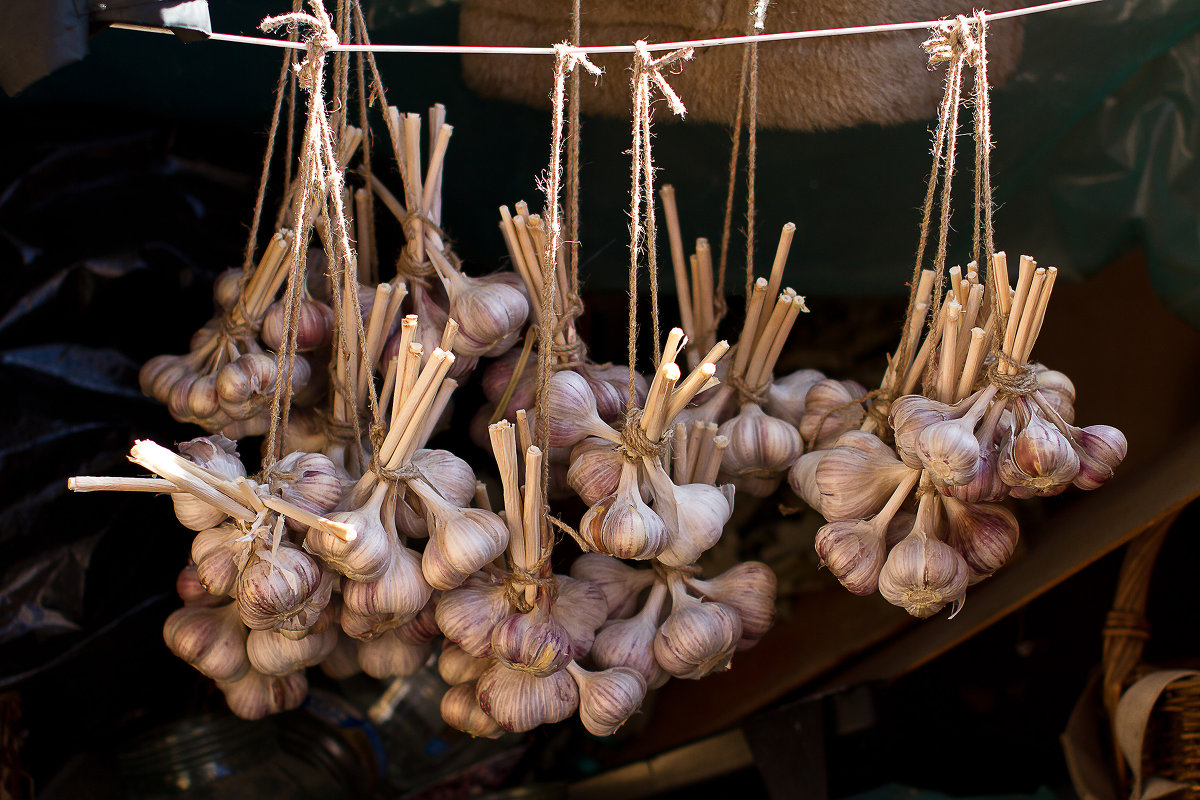 Methods for storing garlic in the winter at home
Methods for storing garlic in the winter at home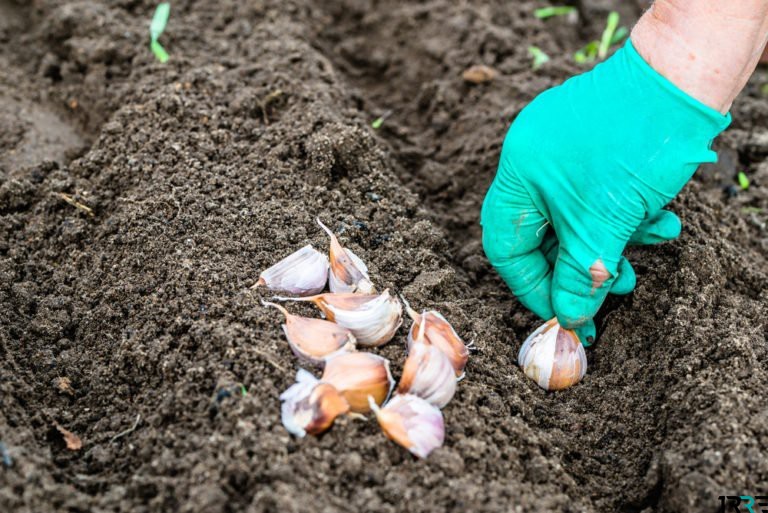 Processing garlic before planting in the winter: soaking garlic and tillage
Processing garlic before planting in the winter: soaking garlic and tillage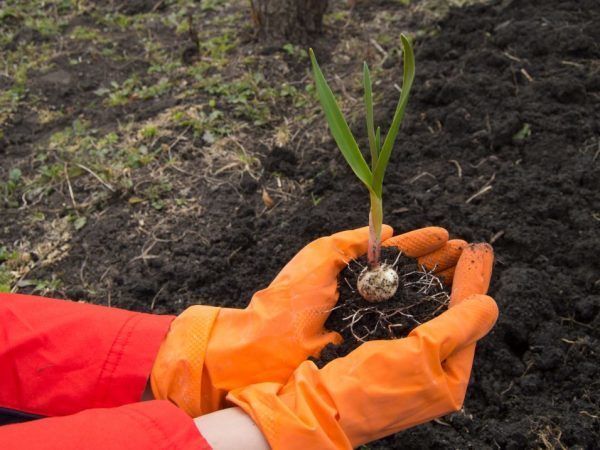 Fertilizers when planting garlic in the fall: how to fertilize the soil
Fertilizers when planting garlic in the fall: how to fertilize the soil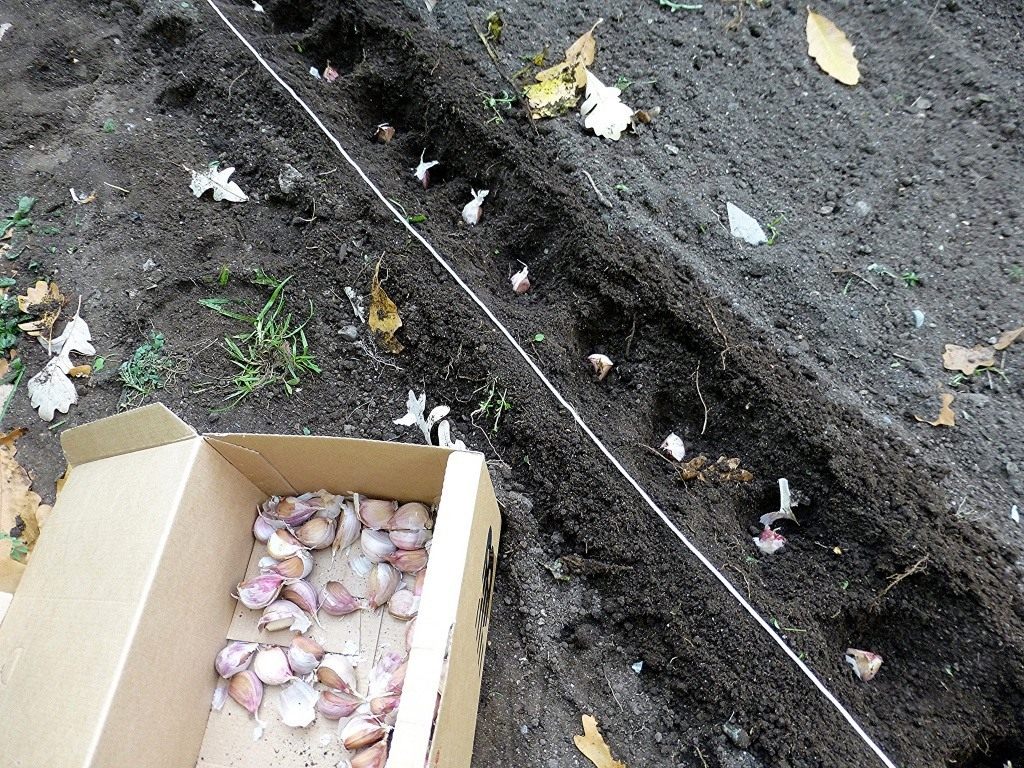 Features planting garlic in the winter in the fall
Features planting garlic in the winter in the fall
The author collected everything that can be collected from all textbooks, specifically nothing. Crap.